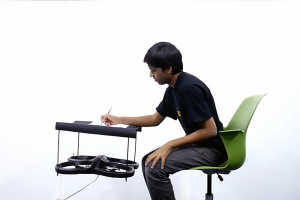MIT Researchers Are Using Drone Technology To Turn Stationary Objects Into Smart Handy Helpers
A desk is just a stationary object, right? Not if these researchers have anything to do with it.
According to MIT researchers, stable, ordinary objects have the ability to be transformed into autonomous smart agents, there to help humans who interact so closely with them.
Harshit Agrawal, a first year Masters student in the Fluid Interface Group at the MIT Media Lab and Sang-Won Leigh, a PhD student also with the MIT Media Lab, are trying to change the way we use everyday appliances by transforming them into more functional, smarter ones by using what they call their L’evolved system.

“Furniture such as tables or lamps have been ubiquitous, present all over the spaces we inhabit. However, their form and our interaction with those utilities haven’t changed much for centuries. Now that we have the technology and the imaginations as we’ve seen from fantasy movies and sci-fi, we hoped to prototype and visualize how a future of close interaction with these utilities can be,” said Leigh.
The duo is harnessing drone technology to make everyday objects more mobile and smart so that they can collaborate with those around them.
In their testing phase, they are controlling a drone from a computer and employing a motion capture system to make their newly constructed drone lamp and table follow a user wherever he or she needs to use these objects.
“We seek to create a world where the utilities around us respond to our actions and help us completing a task. Moreover, these utilities can be smart enough to come to the foreground of interaction to guide,” said Leigh.
What exactly can the technology do?
So, for example, if a user is going to perform a “wrong” task, the table he or she is using can auto-eject and prevent it from happening, or a lamp can guide someone to something they are searching for in the dark.
In their paper, the team describes a scenario where a lamp remembers the last location where the user stopped reading a book and switched off the lamp. When the user returns, the lamp can light up above the book to remind the user where it was left.
The team also envisions L’evolved units being used in furniture so tables can self-lengthen if there are additional guests at your home.
Challenges
As you may assume, the transformation process can pose many challenges. For one, technical challenges like the stability of the drone need to be looked at, as well other drone-related issues like noise and battery life.
“We currently use a tethered drone for long-term applications. Therefore, these might take some time in coming to the market. Our aim was to prototype application and interaction scenarios that haven’t been thought of earlier,” said Leigh.
So for now, don’t expect to see any floating tables or lamps in your home, but Agrawal and Leigh are working on more application areas for the technology and working on ways to make it work easily without too many home-installation hurdles.
Watch the video for more information.

